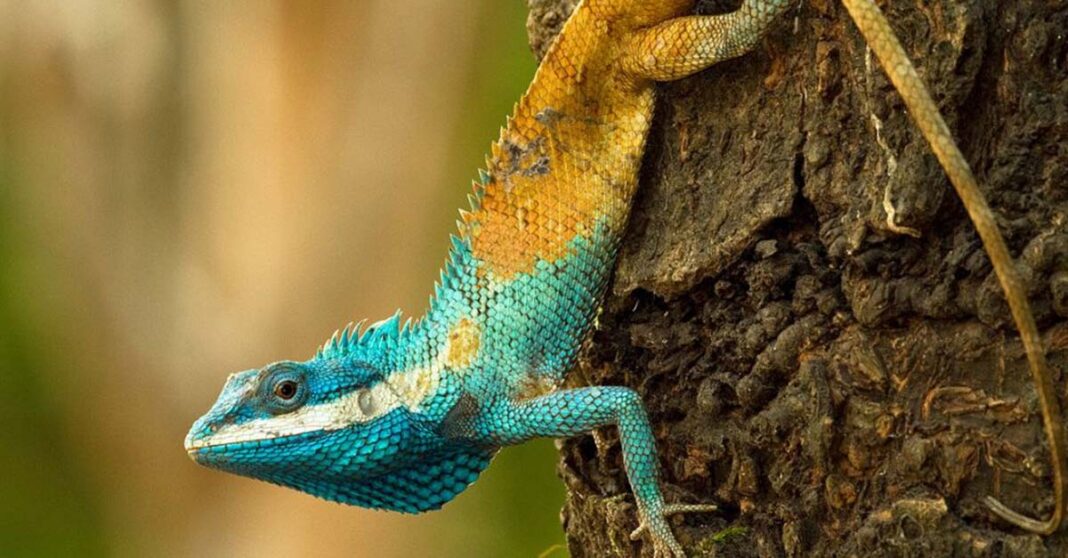A color-changing lizard, a thick-thumbed bat, a poisonous snake named after a Chinese mythological goddess, an orchid that looks like a muppet and a tree frog with skin that resembles thick moss are five of the 380 new species described by scientists in the Greater Mekong region of Southeast Asia in 2021 and 2022, according to a new report released today by WWF.
With many of the species already under threat of extinction from human activities, WWF is calling on governments in the region to increase protection for these rare, amazing creatures and their habitats.
The report documents the work of hundreds of scientists from universities, conservation organizations, and research institutes around the world who discovered 290 plants, 19 fishes, 24 amphibians, 46 reptiles, and one mammal in Cambodia, Laos, Myanmar, Thailand, and Vietnam. This brings the total number of vascular plants, fishes, amphibians, reptiles, birds, and mammals described in the Greater Mekong region since 1997 to 3,390.

“These remarkable species may be new to science but they have survived and evolved in the Greater Mekong region for millions of years, reminding us humans that they were there a very long time before our species moved into this region,” said K. Yoganand, WWF-Greater Mekong regional wildlife lead. “We have an obligation to do everything to stop their extinction and protect their habitats, and help their recovery.”
Highlights of the report include:
- The Cambodian blue-crested agama, an aggressive lizard that changes color as a defensive mechanism and was identified by studying lizards found near an Angkor era archeological site.
- Hayes’ thick-thumbed myotis, a mouse-eared bat with unusual fleshy thumbs that was named a new species after a specimen sat in a Hungarian museum for 20 years.
- Khoi’s mossy frog, a large, spectacular find that is mossy-green colored, which helps it blend into the lichen and moss-covered stony, leafy background
- Dendrobium fuscifaucium, a miniature orchid with brilliant pink and bright yellow coloring that resembles the beloved “Mah na mah na” muppets.
- Suzhen’s krait, an extremely venomous snake, named after Bai Su Zhen, a snake goddess from a Chinese myth called the Legend of the White Snake.
- Cleyera bokorensis, an evergreen shrub threatened by a Cambodian casino, dam, and residential development.
- Vietnam’s Thai crocodile newt is threatened by agricultural encroachment and logging, and collection by communities as a traditional cure for abdominal pain and parasitic infection.
- Thailand’s bent-toed gecko was named after a mythical tree nymph – Rukha Deva – that lives in trees and protects the forests. Discovered in the Tenasserim Mountains bordering Myanmar, It aggressively opens its mouth and waves its tail side-to-side when threatened.
- A new species of gecko was discovered in Laos’ capital city Vientiane, whose home is being fragmented by construction projects.
- A semi-aquatic snake, Hebius terrakarenorum, found in the Dawna-Tenasserim Landscape between Thailand and Myanmar, is 650 mm long and was identified entirely from road-kill specimens collected over a decade and a few photos.
These new species are under intense pressure from deforestation, habitat degradation, road development, loss of streams and rivers, pollution, diseases spread by human activities, competition from invasive species, and the devastating impacts of illegal wildlife trade. Sadly, many species go extinct before they are even discovered.
“Even though reptiles and amphibians may not get as much love from the public, the discovery of these species in Laos represents an amazing biodiversity that is just waiting to be uncovered,” said Dr. Akchousanh Rasphone, Wildlife Lead & Chief Conservation Scientist, WWF-Laos. “One of these species – the gecko Dixonius somchanhae – is not only endemic to Laos but it was also discovered in Vientiane Capital – right under our noses!”
In his foreword to the report, Dr. Truong Q. Nguyen with the Institute of Ecology and Biological Resources at the Vietnam Academy of Science and Technology, notes that immediate action and the increased use of new technologies such as bio-acoustics and genetic sequencing are needed to help scientists discover more species in this biodiversity hotspot. “To reverse the rapid biodiversity loss in the region, more concerted, science-based, and urgent efforts need to be made. And conservation measures need more attention from governments, NGOs, and the public,” he said.
WWF works with government, communities, non-profit and private partners across the five Greater Mekong countries on conservation strategies designed to protect these species and their habitat. They work through these partnerships to protect flagship species such as Asian elephants, Irrawaddy dolphins, and tigers, as well as the forests, rivers, and oceans they depend on. To stop wildlife declines, WWF is strengthening protected areas, and tackling the snaring crisis, illegal wildlife markets, online wildlife trade, and the financial crimes associated with wildlife trafficking.



